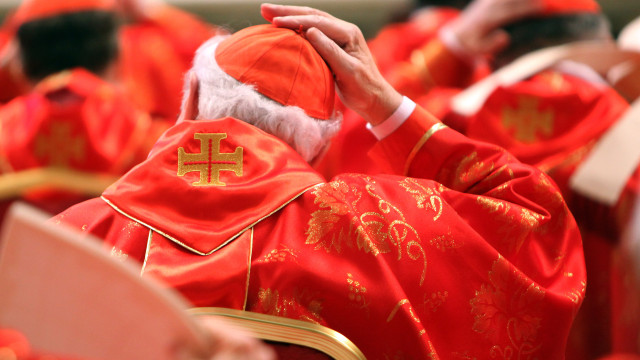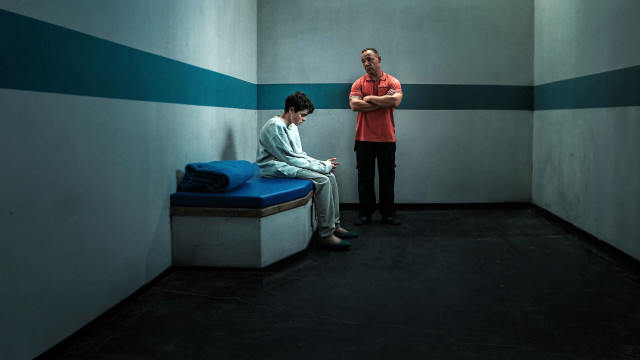






























See Also
See Again
© Getty Images
0 / 31 Fotos
Where is Tinian Island?
- Tinian is one of the three principal islands of the Northern Mariana Islands, an unincorporated territory of the United States set in the northern Pacific Ocean.
© Getty Images
1 / 31 Fotos
Colonial Tinian
- The Mariana Islands were first settled around 1500 to 1400 BCE. Tinian was colonized by the Spanish and later the Germans over a 200-year-plus period, from 1645 to 1899. Significantly, in 1914 during the First World War, the island was captured by the Japanese.
© Getty Images
2 / 31 Fotos
Japanese occupation of Tinian
- Under Japanese rule, extensive infrastructure development took place, including the construction of port facilities, waterworks, power stations, roads, and housing. It was only during the latter stages of the Second World War that Japan realized Tinian's strategic importance as a possible base for American long-range bombers. The island was quickly garrisoned.
© Getty Images
3 / 31 Fotos
Battle of Tinian
- Tinian's strategic location was not lost on the US military either. In 1943, plans were drawn up to seize Tinian along with the neighboring islands of Saipan and Guam. The following year, on July 16, 1944, the Battle of Tinian commenced with a US naval bombardment targeting key Japanese positions.
© Getty Images
4 / 31 Fotos
Battle of Tinian
- The ground offensive followed on July 24 when the 4th Marine Division waded ashore.
© Getty Images
5 / 31 Fotos
Battle of Tinian
- The infantry was supported by continued naval bombardment and artillery fire. In the skies, the US Navy Grumman TBF-1C Avengers (pictured) were among the American bombers providing air support.
© Getty Images
6 / 31 Fotos
Battle of Tinian
- Within a week, Japanese forces had been overwhelmed, although the garrison on Aguiguan Island off the southwest cape of Tinian held out until the end of the war, only surrendering on 4 September 4, 1945. Image: US Marine Corps, 1944
© Public Domain
7 / 31 Fotos
Battle of Tinian
- The short but bloody Battle of Tinian claimed the lives of 368 Marines and 5,745 Japanese combatants. Pictured are captured Japanese soldiers emerging from their hideout.
© Getty Images
8 / 31 Fotos
Aftermath
- Tinian's transport infrastructure had been reduced to rubble, its roads destroyed and its towns and villages resembling matchwood.
© Getty Images
9 / 31 Fotos
Rebuilding Tinian
- But even as the Americans were mopping up, plans were being drawn up to turn the island into an important base for further US operations in the Pacific campaign.
© Getty Images
10 / 31 Fotos
The Seabees
- The Seabees—United States Naval Construction Battalions—were put to work rebuilding Tinian. Camps were built for 50,000 troops, and 15,000 Seabees turned the island into the busiest airfield of the war, creating eight 7,900-ft (2,400 m) runways to accommodate B-29 Superfortress bombers. Image: US Navy
© Public Domain
11 / 31 Fotos
North Field
- Two runway complexes, North Field (pictured) and West Field, were constructed. North Field's runways occupied nearly the entire northern end of the island and at the time stood as the largest airfield in the world.
© Getty Images
12 / 31 Fotos
North Field
- North Field's four enormous parallel runways were oriented nearly east-west. They were complemented by hardstands built for 265 B-29 bombers—exactly what the Japanese had predicted.
© Shutterstock
13 / 31 Fotos
509th Composite Group
- This rare color image of North Field clearly shows B-29 bombers parked over the hardstands. Among the aircraft seen here are those belonging to the 509th Composite Group, a unit tasked with the operational deployment of nuclear weapons. Image: Harold Agnew/US Government
© Public Domain
14 / 31 Fotos
West Field
- West Field and its four runways was home to the 58th Bombardment Wing. This unit was responsible for the deadly attacks on Tokyo and other Japanese cities, plus Japanese targets based as far away as Burma, Thailand, and China. Image: USAF Historical Research Agency, 1945
© Public Domain
15 / 31 Fotos
West Field
- Pictured here is West Field's vast containment area comprising accommodation, warehouse, and mess hall facilities. Image: USAF Historical Research Agency, 1945
© Public Domain
16 / 31 Fotos
The 'Enola Gay' lands on Tinian
- Back on North Field in early August 1945, the B-29 Superfortress 'Enola Gay' maneuvered over a bomb pit to collect a new and terrible weapon.
© Getty Images
17 / 31 Fotos
"Little Boy" is loaded
- Once in position a secret bomb code-named "Little Boy" was slowly deposited into the aircraft's belly.
© Getty Images
18 / 31 Fotos
Historic mission
- On the morning of August 6, 'Enola Gay,' commanded by Colonel Paul W. Tibbets (pictured), took off from Tinian. Its destination was the Japanese city of Hiroshima.
© Getty Images
19 / 31 Fotos
The first nuclear weapon used in warfare
- Several hours later Hiroshima lay in ruins, flattened by the first nuclear weapon used in warfare dropped by the first aircraft to do so.
© Getty Images
20 / 31 Fotos
Deadly bombing run
- A photographer at North Field captured 'Enola Gay' landing back on Tinian after its historic bombing run. Three days later on August 9, a second atomic bomb known as "Fat Man" was collected by another B-29, this one named Bockscar. It was detonated over Nagasaki.
© Getty Images
21 / 31 Fotos
Tinian is abandoned
- With the surrender of Japan, the United States abandoned Tinian Island, although it remained under Washington's influence, becoming part of the Trust Territory of the Pacific Islands controlled by the United States. Pictured in 1971 is the ruined and overgrown headquarters of the Japanese Navy's 1st Air Fleet.
© Getty Images
22 / 31 Fotos
Wartime ruins
- This recent image shows the rusting and eroded interior of the Japanese command center.
© Shutterstock
23 / 31 Fotos
Relics of conflict
- These are the ruins of an abandoned fuel bomb storage by the roadside on Tinian. Relics of the Second World War lie scattered across much of the island.
© Shutterstock
24 / 31 Fotos
Frozen in time
- Here, the ruined shell of a Japanese tank, its barrel long lost, still keeps guard over a former gun emplacement.
© Shutterstock
25 / 31 Fotos
Loading pit No. 2
- The most poignant of Tinian's wartime reminders is the very bomb pit into which "Little Boy" was placed before its fateful delivery to Hiroshima. It's the island's most popular visitor attraction.
© Shutterstock
26 / 31 Fotos
Runways repurposed
- Meanwhile, North Field's near-80-year-old runways, the subject of those recent news reports, remain weather-worn and pocked with weeds. But for how much longer?
© Shutterstock
27 / 31 Fotos
Reclaiming North Field from the jungle
- Much of Tinian is jungle. The runways built all those years ago have been mostly reclaimed by Mother Nature.
© Shutterstock
28 / 31 Fotos
An "extensive" facility
- But according to a CNN report published December 21, 2023, Gen. Kenneth Wilsbach, commander of Pacific Air Forces, told Nikkei Asia in an interview published recently that North Airfield will become an "extensive" facility once work has been completed to reclaim it from the jungle.
© Shutterstock
29 / 31 Fotos
A new defensive front?
- And earlier in fact, in October 2020, battalions of Seabees, the same units responsible for building the original wartime runways, were seen deployed operating heavy equipment and constructing new infrastructure on the Pacific island. Image: US Navy Sources: (CNN) (Nikkei Asia) (The New York Times)
© Public Domain
30 / 31 Fotos
© Getty Images
0 / 31 Fotos
Where is Tinian Island?
- Tinian is one of the three principal islands of the Northern Mariana Islands, an unincorporated territory of the United States set in the northern Pacific Ocean.
© Getty Images
1 / 31 Fotos
Colonial Tinian
- The Mariana Islands were first settled around 1500 to 1400 BCE. Tinian was colonized by the Spanish and later the Germans over a 200-year-plus period, from 1645 to 1899. Significantly, in 1914 during the First World War, the island was captured by the Japanese.
© Getty Images
2 / 31 Fotos
Japanese occupation of Tinian
- Under Japanese rule, extensive infrastructure development took place, including the construction of port facilities, waterworks, power stations, roads, and housing. It was only during the latter stages of the Second World War that Japan realized Tinian's strategic importance as a possible base for American long-range bombers. The island was quickly garrisoned.
© Getty Images
3 / 31 Fotos
Battle of Tinian
- Tinian's strategic location was not lost on the US military either. In 1943, plans were drawn up to seize Tinian along with the neighboring islands of Saipan and Guam. The following year, on July 16, 1944, the Battle of Tinian commenced with a US naval bombardment targeting key Japanese positions.
© Getty Images
4 / 31 Fotos
Battle of Tinian
- The ground offensive followed on July 24 when the 4th Marine Division waded ashore.
© Getty Images
5 / 31 Fotos
Battle of Tinian
- The infantry was supported by continued naval bombardment and artillery fire. In the skies, the US Navy Grumman TBF-1C Avengers (pictured) were among the American bombers providing air support.
© Getty Images
6 / 31 Fotos
Battle of Tinian
- Within a week, Japanese forces had been overwhelmed, although the garrison on Aguiguan Island off the southwest cape of Tinian held out until the end of the war, only surrendering on 4 September 4, 1945. Image: US Marine Corps, 1944
© Public Domain
7 / 31 Fotos
Battle of Tinian
- The short but bloody Battle of Tinian claimed the lives of 368 Marines and 5,745 Japanese combatants. Pictured are captured Japanese soldiers emerging from their hideout.
© Getty Images
8 / 31 Fotos
Aftermath
- Tinian's transport infrastructure had been reduced to rubble, its roads destroyed and its towns and villages resembling matchwood.
© Getty Images
9 / 31 Fotos
Rebuilding Tinian
- But even as the Americans were mopping up, plans were being drawn up to turn the island into an important base for further US operations in the Pacific campaign.
© Getty Images
10 / 31 Fotos
The Seabees
- The Seabees—United States Naval Construction Battalions—were put to work rebuilding Tinian. Camps were built for 50,000 troops, and 15,000 Seabees turned the island into the busiest airfield of the war, creating eight 7,900-ft (2,400 m) runways to accommodate B-29 Superfortress bombers. Image: US Navy
© Public Domain
11 / 31 Fotos
North Field
- Two runway complexes, North Field (pictured) and West Field, were constructed. North Field's runways occupied nearly the entire northern end of the island and at the time stood as the largest airfield in the world.
© Getty Images
12 / 31 Fotos
North Field
- North Field's four enormous parallel runways were oriented nearly east-west. They were complemented by hardstands built for 265 B-29 bombers—exactly what the Japanese had predicted.
© Shutterstock
13 / 31 Fotos
509th Composite Group
- This rare color image of North Field clearly shows B-29 bombers parked over the hardstands. Among the aircraft seen here are those belonging to the 509th Composite Group, a unit tasked with the operational deployment of nuclear weapons. Image: Harold Agnew/US Government
© Public Domain
14 / 31 Fotos
West Field
- West Field and its four runways was home to the 58th Bombardment Wing. This unit was responsible for the deadly attacks on Tokyo and other Japanese cities, plus Japanese targets based as far away as Burma, Thailand, and China. Image: USAF Historical Research Agency, 1945
© Public Domain
15 / 31 Fotos
West Field
- Pictured here is West Field's vast containment area comprising accommodation, warehouse, and mess hall facilities. Image: USAF Historical Research Agency, 1945
© Public Domain
16 / 31 Fotos
The 'Enola Gay' lands on Tinian
- Back on North Field in early August 1945, the B-29 Superfortress 'Enola Gay' maneuvered over a bomb pit to collect a new and terrible weapon.
© Getty Images
17 / 31 Fotos
"Little Boy" is loaded
- Once in position a secret bomb code-named "Little Boy" was slowly deposited into the aircraft's belly.
© Getty Images
18 / 31 Fotos
Historic mission
- On the morning of August 6, 'Enola Gay,' commanded by Colonel Paul W. Tibbets (pictured), took off from Tinian. Its destination was the Japanese city of Hiroshima.
© Getty Images
19 / 31 Fotos
The first nuclear weapon used in warfare
- Several hours later Hiroshima lay in ruins, flattened by the first nuclear weapon used in warfare dropped by the first aircraft to do so.
© Getty Images
20 / 31 Fotos
Deadly bombing run
- A photographer at North Field captured 'Enola Gay' landing back on Tinian after its historic bombing run. Three days later on August 9, a second atomic bomb known as "Fat Man" was collected by another B-29, this one named Bockscar. It was detonated over Nagasaki.
© Getty Images
21 / 31 Fotos
Tinian is abandoned
- With the surrender of Japan, the United States abandoned Tinian Island, although it remained under Washington's influence, becoming part of the Trust Territory of the Pacific Islands controlled by the United States. Pictured in 1971 is the ruined and overgrown headquarters of the Japanese Navy's 1st Air Fleet.
© Getty Images
22 / 31 Fotos
Wartime ruins
- This recent image shows the rusting and eroded interior of the Japanese command center.
© Shutterstock
23 / 31 Fotos
Relics of conflict
- These are the ruins of an abandoned fuel bomb storage by the roadside on Tinian. Relics of the Second World War lie scattered across much of the island.
© Shutterstock
24 / 31 Fotos
Frozen in time
- Here, the ruined shell of a Japanese tank, its barrel long lost, still keeps guard over a former gun emplacement.
© Shutterstock
25 / 31 Fotos
Loading pit No. 2
- The most poignant of Tinian's wartime reminders is the very bomb pit into which "Little Boy" was placed before its fateful delivery to Hiroshima. It's the island's most popular visitor attraction.
© Shutterstock
26 / 31 Fotos
Runways repurposed
- Meanwhile, North Field's near-80-year-old runways, the subject of those recent news reports, remain weather-worn and pocked with weeds. But for how much longer?
© Shutterstock
27 / 31 Fotos
Reclaiming North Field from the jungle
- Much of Tinian is jungle. The runways built all those years ago have been mostly reclaimed by Mother Nature.
© Shutterstock
28 / 31 Fotos
An "extensive" facility
- But according to a CNN report published December 21, 2023, Gen. Kenneth Wilsbach, commander of Pacific Air Forces, told Nikkei Asia in an interview published recently that North Airfield will become an "extensive" facility once work has been completed to reclaim it from the jungle.
© Shutterstock
29 / 31 Fotos
A new defensive front?
- And earlier in fact, in October 2020, battalions of Seabees, the same units responsible for building the original wartime runways, were seen deployed operating heavy equipment and constructing new infrastructure on the Pacific island. Image: US Navy Sources: (CNN) (Nikkei Asia) (The New York Times)
© Public Domain
30 / 31 Fotos
The Pacific airfield being repurposed to counter China
The US is set to recommission old runways in case hostilities break out
© Getty Images
Recent press reports suggest that a tiny island in the Pacific Ocean is set to become a new forward front in the event of hostilities between the United States and China. This has evoked wartime memories of when the island in question, Tinian, served as a US military base in the fight against the Japanese. During WWII, American-operated runways on Tinian served as launch pads for numerous bombing raids, including the fateful attacks on Hiroshima and Nagasaki.
Abandoned for nearly 80 years, these airfields now look set to be recommissioned as Washington voices concern over Beijing's increasing missile threat. But where exactly is Tinian located, and what's the story behind this remote, jungle-clad enclave?
Click through and step back in time to find out.
RECOMMENDED FOR YOU




































MOST READ
- Last Hour
- Last Day
- Last Week








